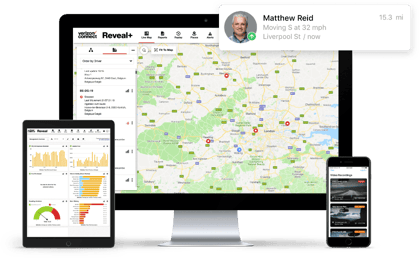Build your advanced fleet safety programme
Develop an advanced fleet safety programme to improve driver behaviour, reduce accidents, and enhance overall safety...
Read more
Now is the perfect time to take a closer look at your fleet safety programme and address. Distracted driving is a significant risk for drivers across the country—in fact, according to research, “distraction is a leading cause of accidents, with a fifth (19%) happening as the driver wasn’t paying attention in the UK” (1).
Distracted driving remains a pressing issue, with a steady increase in deaths tied to it every year.
For commercial fleets, addressing distracted driving is critical to prioritise safety for their drivers and others on the road while also protecting their company's reputation and bottom line. Distracted driving impacts fleet operators in several ways:
What is distracted driving? According to research distracted driving is driving while doing another activity that takes your attention away from the road. Here are the top 10 distractions in the UK according to Vitality (2):
Texting while driving is the most worrisome activity, as it spans all three types of driving distractions. According to the Transport Research Laboratory on behalf of the RAC Foundation, “texting behind the wheel impairs drivers’ reaction times by more than one-third (35%)” (3).
Effectively mitigate distracted driving in your fleet with the three Ts: talk, train and track. These can help you formulate a distracted driving policy.
1. Talk: keep staff lines of communication open.
2. Train: train drivers before they drive.
3. Track: use technology to track data points that help combat distracted driving.
To gain driver buy-in, frame monitoring tools like GPS tracking or AI-powered dashcams as tools to promote the safety and well-being of drivers, rather than a punitive measure. With video evidence on their side, drivers can have peace of mind when dealing with false claims or a no-fault incident. Talking about these topics helps integrate safety and buy-in into the company culture. Once the conversation is in motion, the next step is implementing driver training and coaching to reinforce the importance of addressing distracted driving behaviours.
By utilising GPS tracking technology or AI-powered dashcams to gather visual information about what’s happening on the road and in the cab, fleet managers can gather insights to support safe operations.
Address distracted driving with telematics and driver monitoring systems (DMS) solutions like:
In-cab video gives a holistic picture of driving events and can provide a dual view of the driver and the road. Video evidence can also be used to determine if disciplinary action is needed in the event of a serious driver infraction or can aid in accident investigations and in determinations of liability.
To learn more about how distracted driving impacts commercial fleets and how dashcams can help, dive into 4 useful tips for fleet safety using dashcams for vehicles
Sources:
Tags: Safety




Find out how our platform gives you the visibility you need to get more done.
Develop an advanced fleet safety programme to improve driver behaviour, reduce accidents, and enhance overall safety...
Read moreUsing Vision Zero in your fleet safety programme can help reduce road fatalities and serious injuries. Find out how.
Read moreHere are four ways to focus on fleet safety, including new video-based driver coaching features from Verizon Connect.
Read moreWe surveyed more than 200 fleet managers in The United Kingdom to learn more about the trends and insights within the...
Read more